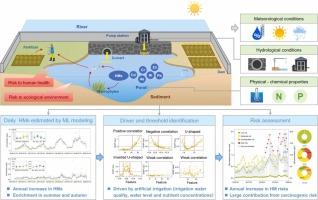人工灌溉调节低地农业池塘重金属动态和风险
IF 11.3
1区 环境科学与生态学
Q1 ENGINEERING, ENVIRONMENTAL
引用次数: 0
摘要
水生生态系统中的重金属威胁着环境和公众健康,因此迫切需要进行高分辨率、动态的风险评估。然而,传统的方法受到HM浓度监测数据稀疏和捕获HM动态与环境条件之间因果关系的能力有限的限制。为了解决这一差距,我们开发了一个机器学习框架,该框架集成了Shapley加性解释(SHAP)分析,以描述HM浓度和风险的日常动态,并通过合并动态系数来量化环境影响。该框架在2016-2019年期间应用于一个低地农业池塘,使用随机森林算法获得了鲁棒性(训练和测试期间的R²>;0.69)。研究期间,模拟和观测数据均呈上升趋势,砷(As)、镉(Cd)和铅(Pb)的季节性峰值出现在夏季或秋季。分析表明,HM富集的环境因子阈值和相互作用模式不同,既有单向(正/负)关系,也有双向(u型/倒u型)关系,其中人工灌溉是关键驱动因素。每日风险评估显示出显著的时间变异性,低、中等、相当和高风险水平分别占研究期间的19%、50%、29%和2%。值得注意的是,总体HM风险主要是由人类致癌风险驱动的,即使在符合水质准则的水平上,人类致癌风险仍然存在。该研究证明了所提出的框架在实现精细风险评估和提高机制理解方面的价值,从而为水管理中的重金属风险控制提供了实际效益。本文章由计算机程序翻译,如有差异,请以英文原文为准。

Artificial irrigation modulates heavy metal dynamics and risks in lowland agricultural ponds
Heavy metals (HMs) in aquatic ecosystems threaten environmental and public health, highlighting the urgent need for high-resolution, dynamic risk assessments. However, conventional methods are constrained by sparse monitoring data of HM concentrations and limited capacity to capture the cause-effect relationship between HM dynamics and environmental conditions. To address this gap, we developed a machine learning framework that integrates Shapley additive explanation (SHAP) analysis to describe daily dynamic of HM concentrations and risks, and to quantify environmental effects by incorporating dynamic coefficients. The framework was applied to a lowland agricultural pond during 2016-2019, and achieved robust performance (R²>0.69 during both training and testing periods) using random forest algorithm. Both simulated and observed data revealed an increasing trend during the study period, with seasonal peaks of arsenic (As), cadmium (Cd) and lead (Pb) in summer or autumn. Our analysis revealed diverse thresholds and interaction patterns of environmental factors governing HM enrichment, ranging from unidirectional (positive/negative) to bidirectional (U-shaped/inverted U-shaped) relationships, with artificial irrigation as the key driver. Daily risk assessments showed substantial temporal variability, with risk levels of low, moderate, considerable, and high accounting for 19%, 50%, 29%, and 2% of the study period, respectively. Notably, overall HM risk was driven predominantly by human carcinogenic risks, which remained present even at levels compliant with water quality guidelines. This study demonstrated the value of the proposed framework in enabling fine-scale risk assessment and improving mechanistic understanding, thereby offering practical benefits for heavy metal (HM) risk control in water management.
求助全文
通过发布文献求助,成功后即可免费获取论文全文。
去求助
来源期刊

Journal of Hazardous Materials
工程技术-工程:环境
CiteScore
25.40
自引率
5.90%
发文量
3059
审稿时长
58 days
期刊介绍:
The Journal of Hazardous Materials serves as a global platform for promoting cutting-edge research in the field of Environmental Science and Engineering. Our publication features a wide range of articles, including full-length research papers, review articles, and perspectives, with the aim of enhancing our understanding of the dangers and risks associated with various materials concerning public health and the environment. It is important to note that the term "environmental contaminants" refers specifically to substances that pose hazardous effects through contamination, while excluding those that do not have such impacts on the environment or human health. Moreover, we emphasize the distinction between wastes and hazardous materials in order to provide further clarity on the scope of the journal. We have a keen interest in exploring specific compounds and microbial agents that have adverse effects on the environment.
 求助内容:
求助内容: 应助结果提醒方式:
应助结果提醒方式:


